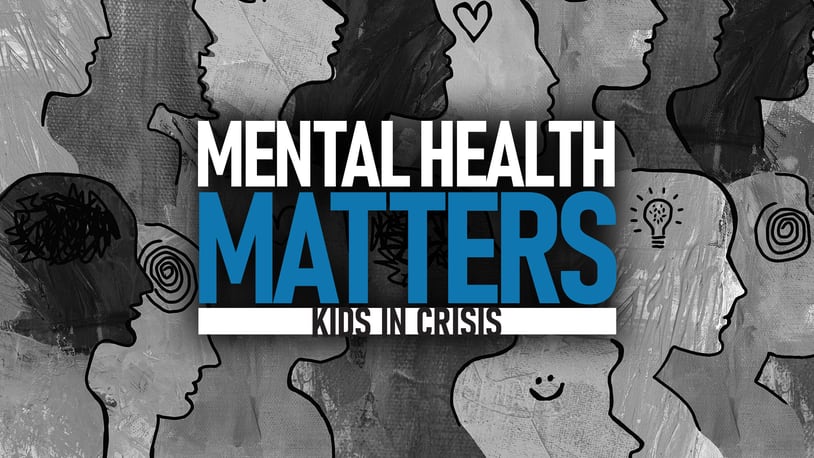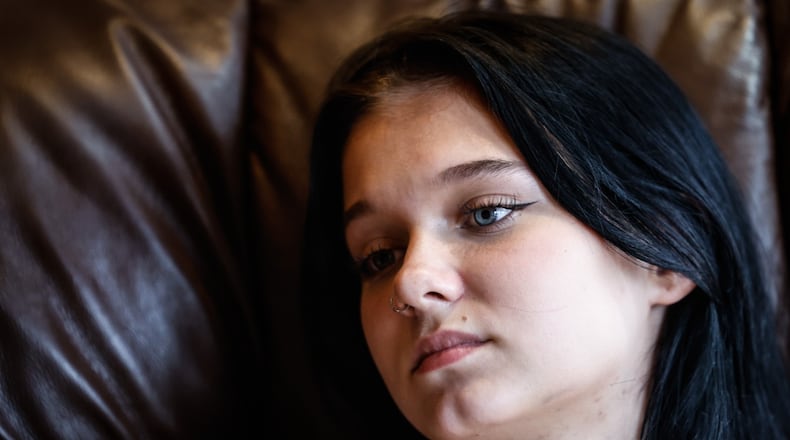It was where she learned to starve herself and where she found a “sponsor” who encouraged her to do it.
“I would post pictures of my body completely malnourished and have people comment on it,” Rhiannon said.
• MENTAL HEALTH MATTERS: More from this project
Rhiannon, now a junior at Springboro High School, experienced depression her freshman year. From stressful and time-consuming extracurricular activities to an eating disorder, her mental health struggles were exacerbated by people she met online.
But she eventually found hope.
“It was very, very rough for a very long time,” Rhiannon said. “Then last summer, I was getting into school and something like snapped, and I was just like, ‘This can’t be my life anymore. I got to get better,’ and I did. And that’s when I stopped self-harming, and I got rid of everything that was terrible in my life.”
Credit: Samantha Wildow
Dr. Kelley Blankenship, the division chief of psychiatry at Dayton Children’s Hospital, said social media can be tricky to navigate. It’s a key way for kids to connect with their friends, but their parents didn’t grow up with it, so they don’t have experience navigating that as a teenager.
“Social media isn’t bad,” she said. “It’s just that kids have to be able to use it in a safe manner.”
This story is part of a Dayton Daily News special reporting project Mental Health Matters: Kids in Crisis. In investigating the role technology and social media play in worsening youth mental health, the Dayton Daily News found:
- Children and teens today are some of the first people to grow up with social media, as well as technology like texting and instant private messaging, which can keep adolescents in constant communication with others.
- Teens who spoke with the Dayton Daily News said even if social media hasn’t touched their own mental health, they have seen its effects on their friends.
- Experts in adolescent behavior and neuropsychology agree high use of social media is linked in multiple studies to worse mental health outcomes.
The world on the web
Online, there are perfectly curated photos portraying people’s best looks and best lives, displayed for everybody else to see.
The harm is adolescents can start to compare themselves and their lives to those pictures online, one local expert says, making them feel like everyone on social media is living better lives, has more friends, and has better looks.
“It really presents ― to especially female adolescents ― really presents to them this world which they’re never going to achieve or never live up to,” Blankenship said.
Several studies, including a 2023 Yale study reviewing brain scans of 9- and 10-year-olds, have linked overuse of the platforms to worse mental health outcomes.
Current young adults are the first generation who grew up with this amount of technology at their fingertips. iPhones weren’t invented until 2007 and smartphones became more common during the 2010s. Instagram was released in 2010. Snapchat was released in 2011. TikTok became big in 2020, when the pandemic forced millions of people out of work and school and into their homes. And the pandemic changed how many people use social media.
“Kids were not having many social interactions, they did not have the predictive routine of wake and sleep schedules, and may have experienced fear about how the pandemic would play out,” said Sheree Coffman, Northmont Schools’ student assistance coordinator. “Many kids relied more heavily on social media for connection, which sometimes worsened mental health.”
Rhiannon, while in the midst of her mental health struggles, found herself seeking out others who could relate, but the support she and others found perpetuated the harm.
“I would use Twitter as a way to connect to other people who were also going through it, but not in like a healthy way,” Rhiannon said.
They set up rules for each other that worsened their eating disorders.
“There were kids younger than me,” Rhiannon said. “There were 13-year-olds on that app, and we would just have a group chat almost of just, ‘What did you guys eat today,’ or, like, ‘what was the calorie count?’”
Cheryl Ferenczi, Rhiannon’s mom, and Rick Price, Rhiannon’s dad, shared the shock they felt when they found out what their daughter was going through and the other ways Rhiannon was hiding her eating disorder, which included purging.
“I felt my heart stop,” Ferenczi said. “It was just, I can’t explain it. There are no words.”
“Shocked is the understatement,” Rick Price said.
Credit: Jim Noelker
Credit: Jim Noelker
Rhiannon also struggled with self-harm, which she was first introduced to in seventh and eighth grades before it really took hold during her freshman year.
“It was just terrible,” Rhiannon said. “It was very difficult to overcome that. It was something that I struggled with very greatly. It was one of the only things that would produce dopamine for me.”
Ferenczi knew something was going on because she was consistently running out of Band-Aids, she said.
Looking back, Rhiannon realized she suppressed a lot of these memories, she said, trying to forget about it.
“I completely forgot how severe it was...Talking about this now, I’m like, I can’t believe I did that,” she said.
She isn’t opposed to looking back at her memories of this time in her life, though, because it’s something she knows other people are still going through, she said.
Hundreds of notifications a day
Other teens have found themselves struggling with social media use.
Credit: Jim Noelker
Credit: Jim Noelker
Grace Weigand is a junior at Vandalia High School. She’s dealt with anxiety, and said limiting her time on social media has helped her manage the condition.
Weigand said she finds herself comparing her own life to others on social media.
“You have to remember that’s not real,” she said.
She has to stop scrolling and ask herself what she can do about it.
“There’s nothing I can do to change that,” she said. “I just like to focus on who I am, you know?”
Weigand said she limits her social media on her phone. On an iPhone, the screen time feature can allow a parent, guardian or even the person themselves to limit apps.
To help herself concentrate better while she’s doing homework, Weigand puts her phone away and silences notifications.
Weigand said she got between 126 and 162 notifications on her phone during the week of Aug. 31 to Sept. 4.
According to a Common Sense Media study, youth ages 11 to 17 get a median of 237 notifications on their phone each day.
Will Ross, an Oakwood High School sophomore, said in middle school, he spent a lot of time on his phone. Ross’s middle school experience coincided with the beginning of the COVID-19 pandemic, when kids were out of school, learning remotely and not seeing their friends.
Credit: Jim Noelker
Credit: Jim Noelker
“I was playing video games all day and on TikTok,” he said.
He and his friends still use a lot of technology to connect. They’ll FaceTime each other just to hang out. They’ll film a TikTok together. They’ll send Snapchat messages.
But Ross says he found he was sadder in the middle school days when he spent more time on his phone.
“Now, I feel really good about my use since I’m really busy,” Ross said. “I think that’s the best way to limit your screen time.”
However, he, like Weigand, finds himself falling into the comparison trap of social media. For him, it’s comparing himself to teens going pro in soccer or lifting more than he can. (Ross said he has not dealt with mental health problems.)
“I think I’m pretty resilient. I’m pretty confident,” he said. “But sometimes that makes me feel less confident about myself.”
Gerry Smith, a Trotwood High School sophomore, said he thinks he spends too much time on his phone. Instagram and Snapchat are his primary social media platforms, but he said he likes to FaceTime and text his friends as well.
Credit: Jim Noelker
Credit: Jim Noelker
Smith went to school near Columbus for a few years and still has friends who live there. His phone is the primary way he can keep in touch.
But his screen time is around nine to 10 hours per day on average, which he says he knows is higher than many of his friends.
“Most kids my age aren’t supposed to be on the phone all the time,” he said. “Some kids are playing sports and others getting out. Spending almost 10 hours a day just on my phone? Whoa...Is that good? Is that good for me?”
‘It’s the emotion that’s completely destroying you’
For Rhiannon and her family, their healing journey had setbacks they had to overcome, including Rhiannon not feeling ready to address her depression.
“I didn’t really want it to go. I was just OK with having it, but it was something that I was also very miserable with,” Rhiannon said.
Rhiannon felt comforted in the emotion, she said, because it was something she was used to for a long time.
Rhiannon was hospitalized four times. There, she met other adolescents who felt similarly, she said.
“You need to identify the fact that that’s not you telling you that you need to stay. It’s the emotion that’s completely destroying you that’s telling you that you need to stay in this feeling,” Rhiannon said. “I think it’s good to identify that.”
Rhiannon’s depression continued until she and one her friends, who was going through a similar experience, decided they each needed a change.
She quit a stressful after-school activity and set boundaries around social media.
“I’m the happiest I’ve been in a very long time,” Rhiannon said.
Credit: Jim Noelker
Credit: Jim Noelker
MENTAL HEALTH MATTERS
A project from the Dayton Daily News

Mental health issues affect all segments of our community, in slightly different ways. Our in-depth reporting focus this year is centered on children through our Mental Health Matters: Kids in Crisis series. With this project, we'll address the larger community in crisis by investigating how mental health issues impact higher education, the workforce and seniors.
- » Our investigation shows how social media is affecting youth mental health
- » How social media impacts your brain
- » Schools say cell phone bans working as attorneys general seek congressional action to address youth social media use
- » Letter from the editor: Mental health is a community challenge we must solve together
- » Sign up for our Mental Health Matters newsletter
- » Full project coverage








